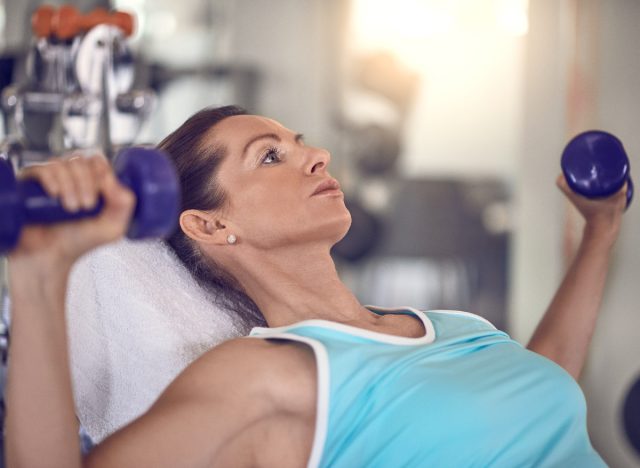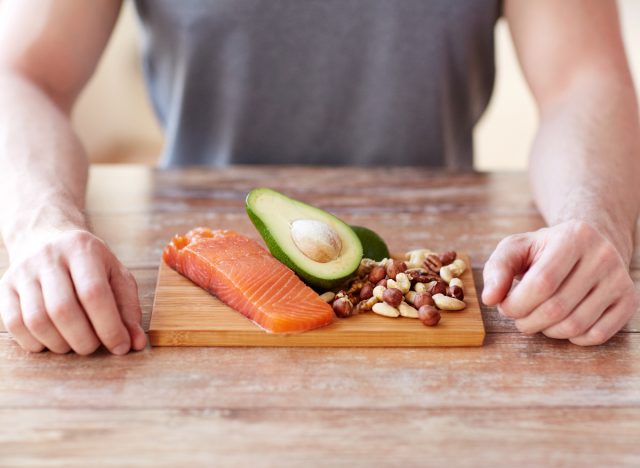Growing older comes with many changes that are difficult to swallow. That’s why developing just the right nutrition and exercise game is key to ensuring your body remains strong, healthy, and fit. We chatted with Stephanie Thomas, a personal trainer on Fyt, who reveals the fitness habits to slow muscle aging after 40. (If you didn’t already know, Fyt is the largest personal training service in the nation that makes guided fitness by a certified professional convenient and accessible for everyone.) Keep reading to find out more.
As you age, you naturally lose muscle mass, function, and strength, which is known as sarcopenia. This is a major contributor and cause of disability among older individuals, according to a review published in the journal Current Opinion in Clinical Nutrition and Metabolic Care. Sarcopenia can boost your risk of suffering from falls and makes you more vulnerable to getting injured. In addition, with age, your bone density declines, and your joints become stiffer. All of this could heighten your risk of developing chronic health issues such as obesity, type 2 diabetes, osteoporosis, and heart disease.
Needless to say, it’s imperative to do everything in your power to stay strong, build and preserve your lean muscle mass, and remain independent. Read on to learn all about the go-to fitness habits to slow muscle aging after 40.


Thomas stresses the importance of performing a strength training program with weights. She suggests first kicking things off without any weights and gradually adding them into your routine once you feel comfortable with your form.
“Don’t be afraid to lift heavier weights than you’re used to. This is key to healthy muscle growth, especially as you age,” Thomas explains, adding, “Always focus on proper form throughout the entire exercise.”
She notes that if you’re a beginner, you’ll find it helpful working alongside a personal trainer. They will curate a productive workout routine to achieve your personal goals, ace the proper form, and learn how to use different gym equipment.
Related: 5 Exercise Habits to Slow Muscle Aging, Trainer Reveals
READ RELATED: Pictured: College student who was killed in Nebraska horror crash along with five others


As previously stated, you lose lean muscle mass as you grow older—anywhere from 3% to 5% every 10 years after you turn 30, in fact (via Harvard Health Publishing). Your percentage of body fat will rise if you don’t follow the necessary steps to build back the lean muscle you lose, Mayo Clinic explains.
Strength training is so important because it aids in building and maintaining muscle mass, no matter how old you are. Performing strength exercises can also help strengthen your bones, manage a healthy weight, and boost your overall quality of life (via Mayo Clinic).
Related: Every Thick Waistline Needs This Visceral Fat Reducer at 60, Trainer Says


Staying on top of your protein intake is the name of the game; Thomas suggests getting enough solid protein every single day. Why, might you ask? Well, protein is crucial when you’re trying to build muscle. The amino acids (which make up protein) assist in restoring and preserving muscle tissue. After wrapping up a sweat session, protein is a major part of the recovery process, since your muscles tear just a bit when working out (via InBody).
“The minimum required daily protein intake is .8 grams per kilogram of body weight. If you’re building muscle, you’ll want to consume more protein than this,” Thomas explains, adding, “It is especially true if you’re trying to build muscle as you age. If your goal is to gain muscle and slow down the aging of your muscles, aim to eat anywhere from 1.2 to 1.8 grams of protein per kilogram of body weight each day.”


Last but not least of these fitness habits to slow muscle aging after 40 is this: Make sure you’re getting your protein from clean, lean sources. Thomas reveals some solid options to consider adding to your diet are lean beef, Greek yogurt, tofu, chickpeas, white meat poultry, shrimp, edamame, and wild-caught fish such as halibut or salmon. “Focus on eating nutritiously balanced meals throughout the day, and include high-quality protein sources as much as possible,” she concludes.
Alexa Mellardo
Source:










